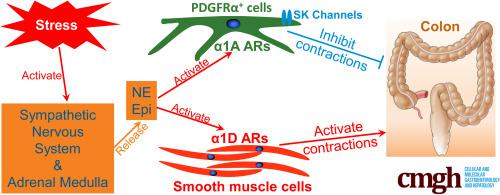Cellular and Molecular Gastroenterology and Hepatology ( IF 7.2 ) Pub Date : 2020-05-04 , DOI: 10.1016/j.jcmgh.2020.04.015 Masaaki Kurahashi 1 , Yoshihiko Kito 2 , Masayasu Hara 3 , Hiromitsu Takeyama 3 , Kenton M Sanders 1 , Hikaru Hashitani 4

|
Background & Aims
Colonic musculature contain smooth muscle cells (SMC), interstitial cells of Cajal (ICC), and platelet-derived growth factor receptor α+ cells (PDGFRα+ cells), which are electrically coupled and operate together as the SIP syncytium. PDGFRα+ cells have enriched expression of small conductance Ca2+-activated K+ (SK) channels. Purinergic enteric neural input activates SK channels in PDGFRα+ cells, hyperpolarizes SMC, and inhibits colonic contractions. Recently we discovered that PDGFRα+ cells in mouse colon have enriched expression of α1A adrenoceptors (ARs), which coupled to activation of SK channels and inhibited colonic motility, and α1A ARs were principal targets for sympathetic regulation of colonic motility. Here we investigated whether PDGFRα+ cells in human colon express α1A ARs and share the roles as targets for sympathetic regulation of colonic motility.
Methods
Isometric tension recording, intracellular recording, and Ca2+ imaging were performed on muscles of the human colon. Responses to α1 ARs agonists or electric field stimulation with AR antagonists and neuroleptic reagents were studied.
Results
Exogenous or endogenous norepinephrine released from nerve fibers inhibited colonic contractions through binding to α1A ARs or enhanced colonic contractions by acting on α1D ARs. Inhibitory responses were blocked by apamin, an antagonist of SK channels. Phenylephrine, α1 AR agonists, or norepinephrine increased intracellular [Ca2+] in PDGFRα+ cells, but not in ICC, and hyperpolarized SMCs by binding to α1 ARs expressed by PDGFRα+ cells.
Conclusions
Human colonic contractions are inhibited by α1A ARs expressed in PDGFRα+ cells and activated by α1D ARs expressed in SMC.
中文翻译:

去甲肾上腺素通过 Alpha 1 肾上腺素能受体的不同亚型对人类结肠收缩具有双重作用。
背景与目标
结肠肌肉组织包含平滑肌细胞 (SMC)、Cajal 间质细胞 (ICC) 和血小板衍生生长因子受体 α +细胞 (PDGFRα +细胞),它们通过电耦合并作为 SIP 合胞体共同运作。PDGFRα +细胞具有丰富的小电导 Ca 2+激活的 K + (SK) 通道的表达。嘌呤能肠神经输入激活 PDGFRα +细胞中的SK 通道,使 SMC 超极化,并抑制结肠收缩。最近我们发现 PDGFRα +小鼠结肠中的细胞富含 α1A 肾上腺素能受体 (ARs) 的表达,这与 SK 通道的激活相结合并抑制结肠运动,而 α1A ARs 是交感神经调节结肠运动的主要目标。在这里,我们研究了人结肠中的PDGFRα +细胞是否表达 α1A ARs 并共享作为结肠运动交感神经调节靶点的作用。
方法
在人类结肠的肌肉上进行等长张力记录、细胞内记录和 Ca 2+成像。研究了对 α1 AR 激动剂或 AR 拮抗剂和精神安定剂的电场刺激的反应。
结果
从神经纤维释放的外源性或内源性去甲肾上腺素通过与 α1A ARs 结合抑制结肠收缩或通过作用于 α1D ARs 增强结肠收缩。抑制反应被 SK 通道的拮抗剂 apamin 阻断。去氧肾上腺素、α1 AR 激动剂或去甲肾上腺素增加PDGFRα +细胞中的细胞内 [Ca 2+ ] ,但不会在 ICC 中增加,并通过与 PDGFRα +细胞表达的α1 AR 结合而使 SMC 超极化。
结论
人结肠收缩被 PDGFRα +细胞中表达的 α1A ARs 抑制,并被SMC 中表达的 α1D ARs 激活。



























 京公网安备 11010802027423号
京公网安备 11010802027423号